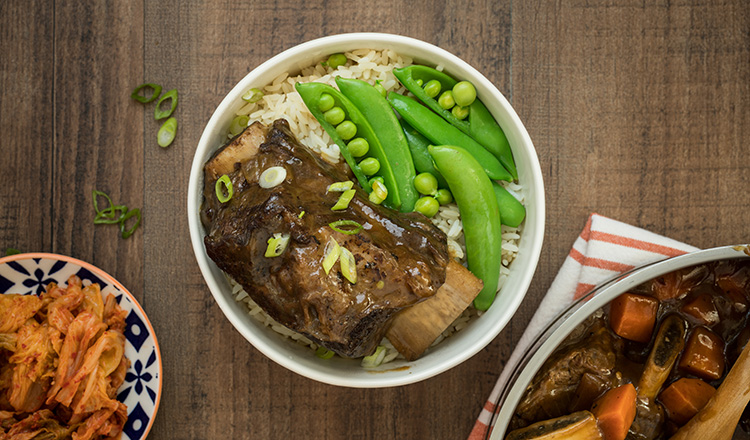Makes 6 to 8 servings
Ingredients
- 2 tablespoons kosher salt
- 2 tablespoons ground ginger
- 2 tablespoons garlic powder
- 2 tablespoons onion powder
- 2 tablespoons freshly ground black pepper
- 1/4 cup all-purpose flour
- 9 lb beef short ribs, bone in
- 1 cup diced onion
- 1/2 cup roughly chopped carrot
- 8 garlic cloves, peeled
- 1/2 cup packed dark brown sugar
- 2 cups beef broth
- 2/3 cup mirin
- 1/2 cup rice wine vinegar
- 1/2 cup soy sauce
- 1 tablespoon fish sauce
- 2 tablespoons cornstarch
- 1 tablespoon plus 2 teaspoons cold water
- 1 bunch scallions, sliced
Directions
- Preheat the oven to 400°F.
- To make the dry rub: Combine the salt, ground ginger, garlic powder, onion powder, pepper, and flour.
- Toss the beef short ribs in the rub to thoroughly coat with as much of the rub as possible. Place the ribs, meat side up, onto a roasting rack and set the rack in a roasting pan. Roast for 30 minutes.
- Add the onion, carrot, and garlic to the roasting pan underneath the rack and immediately return it to the oven. Continue roasting until the ribs look well browned, about 30 minutes. Remove the pan from the oven and reduce the oven temperature to 275°F.
- Remove the ribs, vegetables, and rack from the roasting pan. Drain all of the fat from the bottom of the pan and discard it. Return the ribs and vegetables directly to the pan.
- In a bowl, combine the brown sugar, beef broth, mirin, vinegar, soy sauce, and fish sauce and stir to combine. Pour the mixture over the ribs.
- Cover the pan tightly with aluminum foil. When the oven temperature has reached 275°F, return the pan to the oven. Adjust the oven temperature as necessary to keep the ribs at a very gentle simmer. After 2 hours, start checking the ribs for doneness by piercing them with a wooden skewer or a fork. When the skewer or fork pulls out without picking up any of the meat, the meat is tender and the ribs can be removed from the oven. The ribs may not all finish cooking at the same time; after checking for doneness, return any undercooked ribs to the oven to finish cooking. Keep the cooked ribs warm in a pan loosely covered with foil.
- When all of the ribs have been removed from the pan, strain the cooking liquid from the bottom of the pan through a fine-mesh sieve into a 4-cup measuring container and reserve. Allow the container to sit at room temperature until the fat separates from the usable liquid and floats to the top.
- Meanwhile, remove the meat from the bones and discard the bones. Trim the meat and remove any excess fat and connective tissues.
- When the fat has completely separated from the reserved liquid, skim it off and discard it. You will need 2 cups of the liquid to prepare the sauce; if you don’t have enough liquid after skimming the fat, add enough water to the liquid to make 2 cups. If you have more than 2 cups of liquid, transfer it to a small, uncovered sauce pot and cook over medium heat until the liquid has reduced to 2 cups.
- In a separate container, combine the cornstarch and cold water to make a slurry, stirring until the mixture is smooth. In a small sauce pot over high heat, bring the 2 cups of liquid to a boil, then gradually pour in the slurry while whisking constantly. The sauce will immediately thicken. Quickly remove the pot from the heat and strain the sauce through a fine-mesh strainer.
- Serve the ribs with the sauce and garnish with sliced scallions.


